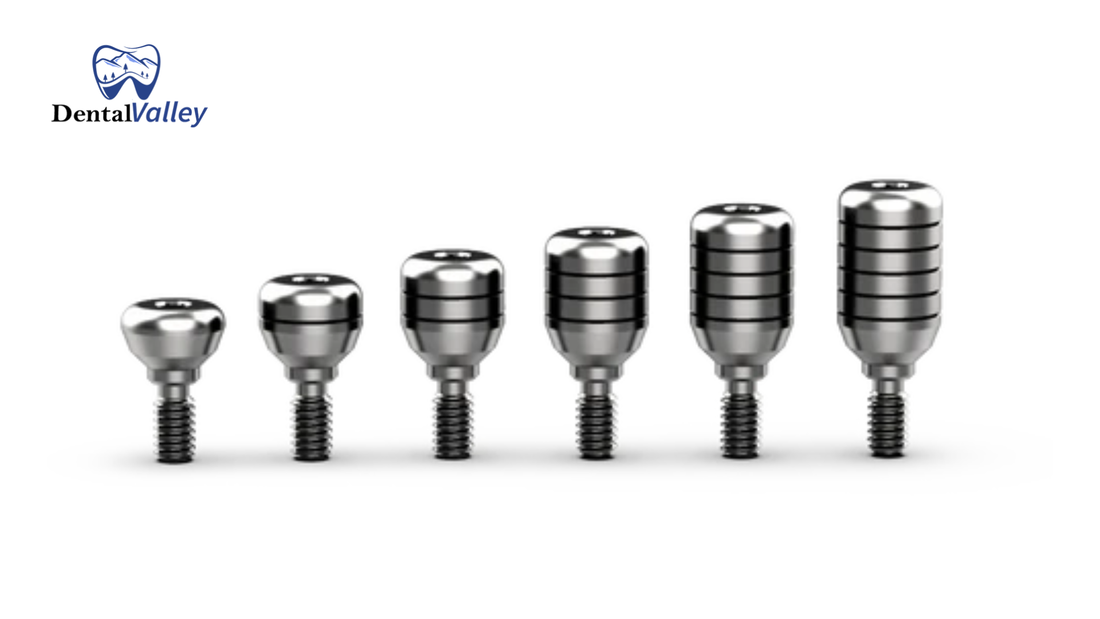Soft tissue healing around implants often determines how confidently a smile returns. A well-chosen healing abutment helps gums to heal properly while keeping your implant treatment on track without delays.
But how do you know which size, height, and shape work best for your implant case especially when every patient’s anatomy and gingival architecture differ?
This guide breaks down how to choose the right healing abutment size to speed up soft tissue maturation while preserving peri-implant health and long-term stability.
Understanding the Role of a Healing Abutment
A healing abutment acts as the transitional piece between the dental implant and the final prosthesis. Once the implant integrates within the bone, the abutment guides soft tissue healing, shaping gum contours to mimic natural tooth emergence.
In simple terms, it creates a biologic seal around the implant to protect underlying structures from bacterial growth and inflammation.
When chosen wisely, the right abutment:
• Accelerates soft tissue recovery
• Maintains gingival harmony and emergence profile
• Reduces chair-time for restorative steps
• Prevents tissue collapse after prosthetic placement
Failure to size it properly, however, can alter gingival architecture, complicate prosthetic seating, and even delay loading protocols.
Why Abutment Size Selection is Important?
The wrong height or diameter can lead to tissue impingement, edema, or poor contour formation. Clinically, the goal is to align abutment size with tissue thickness and implant platform positioning. For example:
• Narrow ridges benefit from a smaller profile to avoid soft-tissue tension.
• Thicker tissue cases may require taller abutments to maintain gingival emergence.
• Deeply placed implants often demand extended collar heights to ensure free tissue adaptation.
The correct healing abutment helps maintain patient comfort during integration and ensures the final prosthetic crown looks natural, not over-contoured.
Step-by-Step Guide to Selecting the Right Healing Abutment Size
1. Assess Soft Tissue Thickness
Use a periodontal probe to measure mucosal depth. For tissues under 2 mm, a lower-profile abutment works best. For thicker tissue, select higher collars for better vertical dimension.
2. Check Implant Depth

If your titanium screw implant is placed sub-crestally, compensate with a taller abutment to elevate soft tissue growth above the bone crest.
3. Match Platform Diameter
Align abutment diameter precisely with the implant system’s platform connection to ensure no micromovement or microbial leakage.
4. Evaluate Gingival Contour Needs
For anterior aesthetics, anatomically contoured abutments help pre-shape the emergence profile for improved esthetics before prosthetic placement.
5. Trial Fit for Tissue Behavior
Allow a short healing period after placement; evaluate tissue adaptation and adjust if needed before proceeding to the impression phase.
How Healing Abutment Design Influences Mucosal Outcomes?
Different systems use varied collar heights and emergence profiles. Some incorporate micro-grooves to encourage fibroblast attachment; others feature polished surfaces to reduce plaque accumulation.
A well-designed prosthetic abutment not only supports tissue shaping but also preserves peri-implant biological width.
Clinicians using castable abutments for dental labs often combine custom design flexibility with pre-engineered healing abutment geometry for precise surgical outcomes. This balance between lab customization and surgical predictability strengthens long-term success rates.
Factors Affecting Soft Tissue Maturation Speed
1. Material Composition
Titanium abutments, especially those matching the titanium dental implant screw, show excellent biocompatibility and epithelial attachment.
Their smooth, corrosion-resistant surface minimizes bacterial adhesion, enhancing early healing.
2. Surface Texture

Highly polished or SLA micro-textured designs promote epithelial attachment. While SLA surface implant options excel in osseointegration, smoother abutment finishes facilitate optimal soft tissue integration.
3. Connection Compatibility
Misalignment between the healing and dental implant connection screw can cause microgaps. Always verify system compatibility before final torquing.
4. Prosthetic Phase Planning
Choosing your healing abutment while considering the final prosthesis dimensions ensures seamless transition between surgical and restorative stages. This prevents misalignment issues that compromise gingival architecture.
Common Mistakes When Choosing Healing Abutment Sizes
• Ignoring Tissue Biotype: Selecting a short abutment on thick tissue can cause collapse after crown placement.
• Overcompression: Tight-fitting abutments may damage tissues and delay healing.
• System Mismatch: Mixing brands without verifying platform fit can compromise sealing.
• Skipping Evaluation: Not reassessing tissue adaptation before final impression often leads to asymmetric results.
Avoiding these pitfalls improves patient satisfaction and minimizes adjustments after prosthesis delivery.
How Healing Abutments Support Long-Term Implant Stability?
Healing abutments play both a biological and mechanical role. By promoting soft tissue sealing, they help isolate the implant interface from bacterial invasion. As a result, they protect the dental structure and maintain a healthy connection point for the final restoration.
Moreover, systematically aligned healing components ensure the longevity of dental implant accessories, supporting the prosthetic workflow from surgery to restoration.
Well-matured tissue further enhances the mechanical integrity of a castable dental abutment during cementation or screw-retained restoration.
The Science Behind Tissue Shaping and Maturation
Tissue adaptation begins immediately after abutment placement. The circular gingival collar gradually forms around the abutment’s shape, following its emergence contour. A well-fitted design helps fibroblasts and epithelial cells create a stable mucosal seal within days.
This biologic process directly influences how natural the future prosthetic appears. Reliable dental implant abutment designs, therefore, serve as a functional matrix guiding this healing behavior.
Additionally, healing performance can be enhanced by pairing implants with high-precision components from reputable dental implant equipment suppliers to ensure uniformity.
Integrating Proper Healing Components Into Surgical Workflows

Streamlined implant procedures depend on thoughtful planning and precision. Using an optimized healing component can dramatically improve efficiency after fixture placement.
Incorporating them into your preoperative surgical toolkit also simplifies inventory and reduces intra-surgical decision fatigue.
For example, as discussed in one of our educational guides on surgical workflow optimization, prioritizing ergonomic, clearly organized component setups reduces the risk of errors and helps maintain sterile field integrity during procedures.
Similarly, insights from guidance on building efficient surgical tray setups demonstrate how anticipating component needs improves both surgical rhythm and postoperative outcomes.
These interconnected principles reflect why clinicians value high-quality healing abutments as an essential step toward successful osseointegration and lasting prosthetic performance.
FAQ: Healing Abutments and Soft Tissue Maturation
Q: How long do healing abutments stay in place?
A: Typically, healing abutments remain for two to six weeks, depending on tissue response and implant depth. Your clinician monitors soft tissue readiness before progressing to impressions.
Q: What happens if the abutment size is wrong?
A: An incorrect size leads to uneven soft tissue contouring or inflammation. It may require replacement to restore ideal emergence and comfort.
Q: Can healing abutments be reused?
A: For clinical hygiene and precision reasons, reusing abutments is not advisable. Each abutment should remain sterile and dedicated to one patient only.
Q: Are titanium abutments better than zirconia?
A: Titanium abutments offer unmatched strength and biocompatibility. Zirconia abutments provide aesthetic advantages, especially for anterior cases, but may not match titanium’s mechanical performance in high-stress regions.
Q: How do healing abutments affect final crown fitting?
A: Correct pre-shaping through healing abutments ensures that the crown margin seats seamlessly, reducing chair-time and improving the aesthetic emergence profile.
Key Takeaways:
• Choosing the right healing abutment accelerates healing time and preserves gingival integrity.
• Always match abutment height, platform compatibility, and tissue biotype for the best results.
• Evaluate material finish and design as they directly affect mucosal adaptation speed.
• Verified precision components from trusted suppliers enhance both clinical confidence and patient satisfaction.
Dental Valley’s Role in Quality Healing Components
At Dental Valley, we offer precision-built healing abutments and related implant accessories engineered for reliable tissue outcomes. Each product undergoes detailed inspection to maintain strength, sterility, and compatibility with top dental implants systems.
Our product line connects expert manufacturing with affordable pricing ensuring global access to safe, predictable implantology tools.
Our portfolio helps clinicians achieve both functional stability and esthetic satisfaction across diverse case complexities.
Bringing It All Together: The Foundation of Successful Healing
Selecting the right healing abutment is about more than mechanical fitting, it’s about biological success and restorative harmony.
Each patient’s tissue anatomy tells a different story, and the right abutment interprets it correctly to form a stable, aesthetic outcome.
Using high-precision components from trusted partners like Dental Valley ensures that both biology and engineering align to produce predictable, long-lasting results.
A strong restoration begins long before the crown; it begins with the healing abutment you choose today.
Start with the right abutment. Start with Dental Valley.

